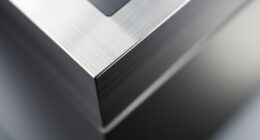To clean old veneer finishes without damage, start by gently dusting with a soft, lint-free cloth or feather duster. For spots, lightly dampen a microfiber cloth with water and wipe carefully, avoiding excess moisture. For stubborn stains, mix mild dish soap with water and wipe gently, then wipe again with a clean cloth to remove soap residue. Using natural oils like mineral oil or a vinegar-olive oil mixture can restore shine safely. Keep reading for more expert tips.
Key Takeaways
- Dust regularly with a soft, lint-free cloth to prevent dirt buildup that can scratch the veneer surface.
- Use a slightly damp microfiber cloth for gentle spot cleaning, avoiding excessive moisture to prevent water damage.
- Avoid harsh chemicals and abrasive tools; opt for natural polishes like mineral oil or beeswax to restore shine safely.
- Test any cleaning or polishing method on a hidden area before applying broadly to prevent unforeseen damage.
- Maintain proper ventilation and gentle handling during cleaning to preserve the veneer’s integrity and prolong its lifespan.

Veneer finishes add a beautiful, natural look to furniture and surfaces, but they can be delicate and easily damaged if cleaned improperly. To keep your furniture looking its best without risking harm, it’s vital to understand the right cleaning techniques. Instead of relying on harsh chemicals or abrasive tools, consider polish alternatives that are gentle yet effective. Natural options like mineral oil or beeswax can restore shine and protect the veneer without stripping away its finish. These alternatives are safer for old veneer and help maintain its integrity over time.
When cleaning veneer, always prioritize cleaning safety tips to avoid accidental damage. First, dust the surface regularly with a soft, lint-free cloth or a feather duster. This prevents dirt and debris from scratching the veneer when you do more thorough cleaning. If you notice smudges or spots, dampen a microfiber cloth slightly with water—never soak it—and gently wipe the surface. Avoid using excessive moisture, as water can seep into the veneer and cause swelling or warping. For stubborn stains, mix a small amount of mild dish soap with water, then wipe gently. Rinse the cloth thoroughly and go over the surface again with just water to remove any soap residue.
When it’s time to polish, skip commercial polishes that contain harsh chemicals. Instead, explore polish alternatives that are safer for vintage and delicate veneer. For example, a mixture of equal parts white vinegar and olive oil can create a natural polish that restores shine and adds a protective layer. Apply it sparingly with a soft cloth, then buff gently until the surface gleams. Always test any polish alternative on a small, inconspicuous area first to ensure it won’t cause discoloration or damage.
Frequently Asked Questions
Can I Use Commercial Cleaners on Vintage Veneer?
You shouldn’t use commercial cleaners with harsh chemicals or abrasive methods on vintage veneer, as they can damage the delicate finish. Stick to gentle, pH-balanced cleaners specifically formulated for wood. Test any cleaner on a hidden area first to guarantee it doesn’t cause discoloration or harm. Avoid aggressive scrubbing, and always wipe with a soft cloth to preserve the veneer’s integrity and beauty for years to come.
How Do I Remove Deep Stains Without Stripping the Finish?
To remove deep stains without stripping the finish, you should use gentle cleaning and stain removal techniques. Start by applying a mixture of mild soap and water or a specialized veneer cleaner with a soft cloth. For stubborn stains, gently rub with a paste made of baking soda and water, then wipe clean. Always test on a small, hidden area first to confirm it won’t damage the finish.
Is Waxing Safe for Old Veneer Surfaces?
Waxing is generally safe for old veneer surfaces if you choose the right product and apply it carefully. Waxing helps preserve veneer by providing a protective layer that guards against moisture and dirt. To guarantee veneer preservation, use a soft cloth and gentle pressure, avoiding excessive waxing. Always test a small, hidden area first to check for any adverse reactions, ensuring your vintage piece stays beautiful and protected.
How Often Should I Clean Antique Veneer Furniture?
You should clean your antique veneer furniture every 6 to 12 months to maintain its beauty. Use gentle cleaning techniques, like a soft cloth or a slightly damp microfiber cloth, to remove dust and dirt. Preservation tips include avoiding harsh chemicals and excessive moisture, which can damage the veneer. Regular, careful cleaning helps preserve the finish and prolongs the life of your furniture without risking harm.
What Are Signs of Damage After Cleaning Veneer?
Did you know that improper cleaning causes nearly 60% of veneer damage? After cleaning, look for signs of damage like peeling, bubbling, or discoloration, which indicate issues with your cleaning aftermath. These damage signs often appear if harsh products or excessive moisture are used. To prevent this, always use gentle cleaners and avoid soaking the veneer. Spotting these signs early helps you preserve your antique furniture’s beauty and integrity.
Conclusion
With gentle care, you can restore your veneer’s natural luster, like a whisper of wind stirring calm waters. Imagine each soft swipe revealing a brighter, more vibrant surface, free from scratches and dullness. By following these simple steps, you preserve the beauty beneath, allowing it to shine through like sunlight breaking over a peaceful lake. Keep your touch light and your patience steady, and your veneer will continue to tell its story for years to come.









